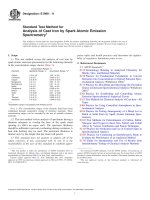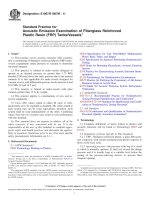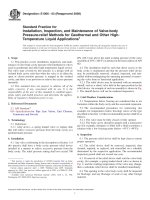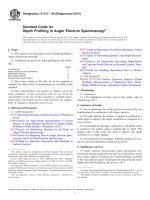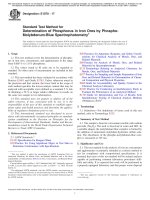Astm e 1187 97
Bạn đang xem bản rút gọn của tài liệu. Xem và tải ngay bản đầy đủ của tài liệu tại đây (41.42 KB, 4 trang )
An American National Standard
Designation: E 1187 – 97
Standard Terminology Relating to
Conformity Assessment1
This standard is issued under the fixed designation E 1187; the number immediately following the designation indicates the year of
original adoption or, in the case of revision, the year of last revision. A number in parentheses indicates the year of last reapproval. A
superscript epsilon (e) indicates an editorial change since the last revision or reapproval.
Building Components in Accordance with Test Methods
Promulgated by ASTM Committee E-164
E 1267 Guide for ASTM Standard Specification Quality
Statements5
2.2 ANSI Standard:
A3-1987 Quality Systems Terminology6
2.3 ISO Standard:
ISO/Guide 2 General Terms and Their Definitions Concerning Standardization, Certification and Testing Laboratory
Accreditation7
2.4 Other Document:
Laboratory Accreditation—Principles and Practice, Collected Reports 1979-1983 (ILAC Task Force C Reports)8
1. Scope
1.1 This standard defines terms related to conformity assessment.2 It includes terms used in those standards under the
jurisdiction of ASTM Committee E-36. When definitions are
those used by other ASTM committees, the committee designation is given in parentheses after the definition. When
definitions are based on those used by other organizations, the
symbol or abbreviation of the name of the organization is
given. In either case, a postscript letter is used to indicate the
degree of correspondence between the definition given herein
and that in the citation. Postscript “A” indicates the definition
is identical to the definition cited by the organization indicated.
Postscript “ B” indicates the given definition is a modification
of that cited, though the essential meaning differs little.
Postscript “ C” indicates the given definition differs substantially from the one cited.
1.2 Since conformity assessment is being carried out by
many accrediting bodies in several fields of testing and
numerous product areas, usage of descriptive terms varies
considerably. There is no attempt to include all conformity
assessment terms in this standard, but to concentrate on those
most commonly encountered.
3. Terminology : Terms and Their Definitions
accreditation—procedure by which an authoritative body
gives formal recognition that a body or person is competent
to carry out specific tasks, (ISO Guide 2).
accreditation criteria, for laboratory accreditation, n—set of
requirements used by an accrediting body which a testing
laboratory must meet to be accredited, (ISO Guide 2, A).
accredited laboratory—testing laboratory to which accreditation has been granted, (ISO Guide 2, A).
accredited laboratory test report—test report that includes a
statement by the testing laboratory that it is accredited for the
test reported and that the test has been performed in
accordance with the conditions prescribed by the accrediting
body, (ISO Guide 2, A).
accrediting body—governmental or non-governmental body
that conducts and administers a laboratory accreditation
system and grants accreditation, (ISO Guide 2, A).
assessment, of a laboratory—the activity of evaluating a
laboratory’s compliance with accreditation criteria.
2. Referenced Documents
2.1 ASTM Standards:
E 10 Test Method for Brinell Hardness of Metallic Materials3
E 18 Test Methods for Rockwell Hardness and Rockwell
Superficial Hardness of Metallic Materials3
E 92 Test Method for Vickers Hardness of Metallic Materials3
E 384 Test Method for Microhardness of Materials3
E 699 Practice for Criteria for Evaluation of Agencies
Involved in Testing, Quality Assurance, and Evaluating
1
This terminology is under the jurisdiction of ASTM Committee E-36 on
Criteria for the Evaluation of Testing and Inspection Agencies and is the direct
responsibility of Subcommittee E36.50 on Support Operations.
Current edition approved Oct. 10, 1997. Published March 1998. Originally
published as E 1187 – 87. Last previous edition E 1187 – 96.
2
There were numerous other sources consulted, but not specifically used, to
formulate definitions for the above terms.
3
Annual Book of ASTM Standards, Vol 03.01.
4
Annual Book of ASTM Standards, Vol 04.07.
Annual Book of ASTM Standards, Vol 14.02.
6
Available from American National Standards Institute, 1430 Broadway, NY,
NY 10018.
7
Available from ISO, 1 rue de Varembé, Case Postale 56, Crt 1221. Geneve 20,
Switzerland.
8
Available from American Association for Laboratory Accreditation, 656 Quince
Orchard Rd.-704, Gaithersburg, MD 20878.
5
Copyright © ASTM International, 100 Barr Harbor Drive, PO Box C700, West Conshohocken, PA 19428-2959, United States.
1
E 1187 – 97
any conflicting arguments, (ISO Guide 2).
deficiency—departure from, or noncompliance with, specified
accreditation criteria.
entity—that which can be individually described and considered.
assessor, of a laboratory—an individual who carries out some
or all functions related to laboratory assessment, (ISO Guide
2, B).
assurance of conformity—procedure resulting in a statement
giving confidence that a product, process or service fulfills
specified requirements, (ISO Guide 2).
DISCUSSION—An entity may be, for example: an activity or process,
a product, an organization, a system or a person, or any combination
thereof.
DISCUSSION—for a product, the statement may be in the form of a
document, a label or other equivalent means. It may also be printed in
or applied on a communication, a catalog, an invoice, a user instructions manual, etc. relating to the product.
field of testing—broad sphere of science, engineering, or
technology used to describe a general area of testing for
classification purposes only. (For accreditation purposes,
fields of testing are subdivided into specific tests, groups of
tests, or product areas.)
generic
criteria,
for
laboratory
accreditation,
n—accreditation criteria expressed in general terms which
address organization, human and material resources, operating procedures, calibration and quality assurance practices of
a laboratory.
inspection—process of measuring, examining, testing, gaging,
or using other procedures to ascertain the quality or state,
detect errors or defects, or otherwise appraise materials,
products, services, systems, or environments to a preestablished standard.
inspection agency—see inspection body, (ISO Guide 2).
inspection body—body that performs inspection services on
behalf of a certification body, (ISO Guide 2).
interlaboratory test comparison—organization, performance
and evaluation of tests on the same or similar items or
materials by two or more laboratories in accordance with
predetermined conditions, (ISO Guide 2).
laboratory accreditation—formal recognition that a testing
laboratory is competent to carry out specific tests or specific
types of tests, (ISO Guide 2, B).
laboratory accreditation system—system having its own
rules of procedure and management, for carrying out laboratory accreditation, (ISO Guide 2, A).
laboratory assessor—person who carries out some or all
functions related to laboratory assessment, (ISO Guide 2).
mark of conformity, (for certification)—protected mark, applied or issued under the rules of a certification system,
indicating that adequate confidence is provided that the
relevant product, process or service is in conformity with a
specific standard or other normative document, (ISO Guide
2).
multilateral arrangement—recognition arrangement that
covers the acceptance of each other’s results by more than
two parties, (ISO Guide 2)
nonconformity—the nonfulfillment of specified requirements,
(ISO 8402).
proficiency testing—determination of laboratory testing performance by means of interlaboratory test comparisons,
(ISO Guide 2).
quality—totality of characteristics of an entity that bear on its
ability to satisfy stated or implied needs.
authority—body that has legal powers and rights, (EN 45020).
bilateral agreement—recognition arrangement that covers
acceptance of each other’s results by two parties, (ISO Guide
2).
calibration—the set of operations that establishes, under
specified conditions, the relationship between values indicated by a measuring instrument or measuring system, or
values represented by a material, and the corresponding
known values of measurement, (ISO Guide 25).
calibration laboratory—laboratory that performs calibration,
(ISO Guide 25).
calibration method—defined technical procedure for performing a calibration, (ISO Guide 25).
certificate of competence—document issued under the rules
of a certification system indicating that adequate confidence
is provided that the named person is competent in performing specific services, (EN 45020).
certificate of conformity—document issued under the rules of
a certification system, indicating that adequate confidence is
provided that a duty identified product, process or service is
in conformity with a specific standard or other normative
document, (ISO Guide 2).
certification body—body that conducts certification of conformity, (ISO Guide 2).
DISCUSSION—A certification body may operate its own testing and
inspection activities or oversee these activities carried out on its behalf
by other bodies, (ISO Guide 2).
certification scheme—certification system as related to specified products, processes or services to which the same
particular standards and rules, and the same procedure,
apply, (ISO Guide 2).
certification system—system that has its own rules of procedure and management for carrying out certification of
conformity, (ISO Guide 2).
conformity—fulfillment by a product, process or service of
specified requirements, (ISO Guide 2).
conformity surveillance—evaluation for conformity to determine the continuing conformity with specified requirements,
(ISO Guide 2).
conformity testing—evaluation for conformity by means of
testing, (EN 45020).
consensus—general agreement, characterized by the absence
of substantial issues by any important part of the concerned
interests and by a process that involves seeking to take into
account the views of all parties concerned and to reconcile
2
E 1187 – 97
quality plan—a document setting out the specific quality
practices, resource and sequence of activities relevant to a
particular product, service, contract or project, (ISO 8402).
quality policy—overall intentions and direction of an organization with regards quality, as formally expressed by top
management.
DISCUSSION—In a contractual environment, or in a regulated environment, such as the nuclear safety field, needs are specified, whereas
in other environments, implied needs should be identified and defined.
In many instances, needs can change with time; this implies a
periodic review of requirements for quality.
Needs are usually translated into characteristics with specified
criteria. Needs may include, for example, aspects of performance,
usability, dependability (availability, reliability, maintainability).
DISCUSSION—The quality policy forms one element of the corporate
policy and is authorized by top management.
quality assurance—all the planned and systematic activities
implemented within the quality system, and demonstrated as
needed, to provide adequate confidence that an entity will
fulfill requirements for quality.
quality surveillance—continual monitoring and verification
of the status of an entity and analysis of records to ensure
that specified requirements are being fulfilled.
DISCUSSION—There are both internal and external purposes for
quality assurance: internal quality assurance: within an organization,
quality assurance provides confidence to the management; external
quality assurance: in contractual or other situations, quality assurance
provides confidence to the customers or others.
Some quality control and quality assurance actions are interrelated.
Unless requirements for quality fully reflect the needs of the user,
quality assurance may not provide adequate confidence.
DISCUSSION—Quality surveillance may be carried out by, or on behalf
of, the customer.
Quality surveillance may include observing and monitoring controls which can prevent the deterioration or degradation of an entity
with time.
“Continual” may mean either constant or frequent.
quality system—organizational structure, procedures, processes and resources needed to implement quality management.
quality audit—systematic and independent examination to
determine whether quality activities and related results
comply with planned arrangements and whether these arrangements are implemented effectively and are suitable to
achieve objectives.
DISCUSSION—The quality system should be as comprehensive as
needed to meet the quality objectives.
The quality system of an organization is designed primarily to
satisfy the internal managerial needs of the organization. It is broader
than the requirements of a particular customer, who evaluates only the
relevant part of the quality system.
DISCUSSION—The quality audit typically applies to, but is not limited
to, a quality system or elements thereof, to processes, to products or to
services. Such audits are often called “quality system audit,”“ process
quality audit,” “product quality audit” or“ service quality audit.”
Quality audits are carried out by staff not having direct responsibility in the areas being audited but, preferably, working in cooperation
with the relevant personnel.
One purpose of a quality audit is to evaluate the need for
improvement or corrective action. An audit should not be confused with
quality surveillance or inspection activities performed for the purpose
of process control or product acceptance.
Quality audits can be conducted for internal or external purposes.
reciprocity—bilateral relationship where both parties have the
same rights and obligations towards each other, (ISO Guide
2).
recognition agreement—agreement that is based on the acceptance by one party of results, presented by another party,
from implementation of one or more designated functional
elements of a certification system, (ISO Guide 2).
DISCUSSION—Typical examples of recognition arrangements are testing arrangements, inspection arrangements and certification arrangements.
quality control—operational techniques and activities that are
used to fulfill requirements of quality.
reference material—material or substance, one or more properties of which are sufficiently well established to be used for
the calibration of an apparatus, the assessment of a measurement method, or for assigning values to materials, (ISO
Guide 2, A).
registration—procedure by which a body indicates relevant
characteristics of a product, process or service, or particulars
of a body or person, in an appropriate, publicly available list,
(ISO Guide 2).
requirement—a translation of the needs into a set of individual quantified or descriptive specifications for the characteristics of an entity in order to enable its realization and
examination, (ISO Guide 25).
specific criteria , n—accreditation criteria related to the ability
of a laboratory to conduct specific tests or specific types of
tests.
standardization—correlation of an instrument response to a
standard of known accuracy.
supplier—the party that is responsible for the product, process
or service and is able to ensure that quality assurance is
DISCUSSION—Quality control involves operational techniques and
activities aimed both at monitoring a process and at eliminating causes
of unsatisfactory performance at all stages of the quality loop in order
to achieve economic effectiveness.
Some quality control and quality assurance actions are interrelated.
quality management—all activities of the overall management function that determine the quality policy objectives
and responsibilities, and implement them by means such as
quality planning, quality control, quality assurance and
quality improvement within the quality system.
DISCUSSION—Quality management is the responsibility of all levels of
management but must be led by top management. Its implementation
involves all members of the organization.
In quality management, consideration is given to economic
aspects.
quality manual—a document stating the quality policy, quality system and quality practices of an organization, (ISO
Guide 25).
3
E 1187 – 97
exercised. The definition may apply to manufacturers, distributors, importers, assembles, service organizations, etc.,
(EN 45020).
supplier declaration—procedure by which a supplier gives
written assurance that a product, process or service conforms
to specified requirements, (ISO Guide 2).
whereby it can be related to appropriate standards, generally
international or national standards, through an unbroken
chain of comparison, (ISO Guide 2).
traceability, n—the ability to trace the history, application, or
location of an item or activity and like items or activities by
means of recorded identification. (ANSI/ASQC-1987, A)
DISCUSSION—In order to avoid any confusion, the expression “selfcertification” should not be used.
DISCUSSION—Traceability requirements should be specified for some
stated period of history or some point of origin.
DISCUSSION—Traceability may be used in three major senses: ( 1) in
a distribution sense relating to components and materials used in
making a product or providing a service, (2) in a calibration sense
relating measuring equipment to national or international standards,
primary standards, or basic physical constants or properties, (3) in a
data sense relating to operational, computational and recording steps of
a measurement or evaluation of a product, process, or service.
test—technical operation that consists of the determination of
one or more characteristics of a given product, process or
service according to a specified procedure, (ISO Guide 2).
testing agency—see testing laboratory.
test method—defined technical procedure to determine one or
more specified characteristics of a material or product, (ISO
Guide 2, A).
test report—document that presents test results and other
information relevant to a test, (ISO Guide 2, A).
testing—action of carrying out one or more tests, (ISO Guide
2).
testing laboratory—laboratory that measures, examines, tests,
calibrates, or otherwise determines the characteristics or
performance of materials or products, (ISO Guide 2, A).
third party—person or body that is recognized as being
independent of the parties involved, as concerns the issue in
question, (ISO Guide 2).
traceability—the property of a result of a measurement
unilateral arrangement—recognition arrangement that covers the acceptance of one party’s results by another party,
(ISO Guide 2).
verification—checking or testing to assure conformance with
the specification, (Test Method E 384, Committee E-4; Test
Method E 10, Committee E-28; Test method E 18, Committee E-28; Test Method E 92, Committee E-28).
verification of conformity—confirmation by examination of
evidence, that a product, process or service fulfills specified
requirements, (ISO Guide 2).
ASTM International takes no position respecting the validity of any patent rights asserted in connection with any item mentioned
in this standard. Users of this standard are expressly advised that determination of the validity of any such patent rights, and the risk
of infringement of such rights, are entirely their own responsibility.
This standard is subject to revision at any time by the responsible technical committee and must be reviewed every five years and
if not revised, either reapproved or withdrawn. Your comments are invited either for revision of this standard or for additional standards
and should be addressed to ASTM International Headquarters. Your comments will receive careful consideration at a meeting of the
responsible technical committee, which you may attend. If you feel that your comments have not received a fair hearing you should
make your views known to the ASTM Committee on Standards, at the address shown below.
This standard is copyrighted by ASTM International, 100 Barr Harbor Drive, PO Box C700, West Conshohocken, PA 19428-2959,
United States. Individual reprints (single or multiple copies) of this standard may be obtained by contacting ASTM at the above
address or at 610-832-9585 (phone), 610-832-9555 (fax), or (e-mail); or through the ASTM website
(www.astm.org).
4


